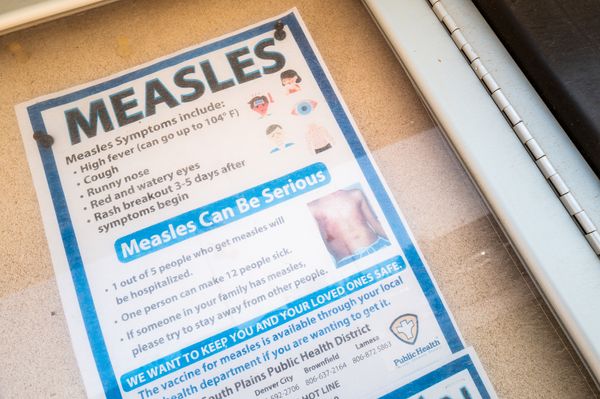
A coalition of hundreds of environmental activists, Navajo and Havasupai tribal members are protesting the transportation of uranium ore through the Navajo Nation, as a newly opened mine near the Grand Canyon resurfaces a painful legacy of nuclear development.
Located just seven miles south of the famous national park, the controversial Pinyon Plain mine is one of the first uranium mines to open in years as the United States works to boost its nuclear arsenal and energy supply.
Protests were rapidly organized over the weekend after news broke that Energy Fuels, the company that owns and operates the mine, had begun transporting dozens of tons of uranium across the Navajo Nation without alerting the nation’s leadership, a move that the tribe views as an illegal violation of laws that prohibit uranium shipping on its land.
Protesters gathered at several events along the 350-mile long fuel shipping route that trucks will take as they transport ore from Pinyon Plain for processing at White Mesa Mill in Blanding, Utah. On Friday, about 50 people marched in Cameron, Arizona, alongside the Navajo Nation’s president, Buu Nygren, and first lady, Jasmine Blackwater-Nygren.
On Saturday in Flagstaff, Arizona, protesters gathered outside city hall, holding aloft signs that read “Haul No!” and “Respect Tribal Sovereignty”. And on Sunday, more than 100 people – including members of the Havasupai tribe who live in the Grand Canyon – marched in Grand Canyon Junction, Arizona.
The renewal of uranium mining and shipping across the region has touched a nerve because of its troubled health and environmental legacy on the Navajo Nation, where more than 500 abandoned uranium mines remain. The US government extracted 30m tons of uranium ore on Navajo Nation land from 1944 to 1986, beginning as part of the Manhattan Project. Many Navajo men labored in the mines, where the health risks of doing so were not well communicated.
Today, families continue to link health issues – particularly high rates of kidney disease, cancer and reproductive disorders – to the mines. In 1979, the nation was home to the largest radioactive spill on US soil – larger than the accident at Three Mile Island – when a dam burst at the Church Rock uranium mill, flooding the Puerco River with 94m gallons of radioactive waste.
“The Havasupai have been fighting the Pinyon Plain mine since the 80s, for decades,” said Leona Morgan, co-founder of Haul No!, a Navajo/Diné-led group focused on ending uranium extraction. “As Diné people, we’re dealing with all the past mining still.”
Mining ore near these tribal lands “risks the waters of the Grand Canyon and puts at risk the people along the haul route”, said Sandy Bahr, director of the Sierra Club’s Grand Canyon Chapter and one of the organizer’s of Sunday’s march.
The transport of uranium ore across Navajo Nation comes as the US is reinvesting in nuclear energy and building up its nuclear arsenal. At Cop28, the US endorsed an agreement to triple nuclear energy production to combat climate change, boosting the demand for uranium.
Mark Chalmers, the president and CEO of Energy Fuels, argued that opposition to the mine is “rooted in outdated fears from the legacy of uranium mining from the 1940s through 1960s, which is not representative of the strict regulations and high environmental and safety standards of today’s industry”.
“With this transport, we can work together to combat climate change, while meeting the growing demand for clean energy and reducing reliance on Russia for uranium and critical minerals,” Chalmers said in a statement to the Guardian.
The reopening of Pinyon Plain has been steeped in controversy. Last August, Joe Biden signed a proclamation establishing a national monument around the Grand Canyon and banning future uranium mining there as well – but Pinyon Plain mine was exempted and began operating in January.
More actions have been organized in the days ahead, including a performance by the musician Ed Kabotie in Tuba City and another protest in Grand Canyon Junction on 24 August. At the same time, Navajo leaders have taken steps to halt shipments across their lands in an effort that will test the limits of tribal sovereignty.
“They snuck through the Navajo Nation and they made it onto the Utah side, outside of the reservation,” said Nygren, the Navajo president, in a press release. Nygren views the mining company’s actions as a violation of a 2012 law banning the transport of uranium on Navajo Nation, although that law did include an exemption for the state and federal highways that Energy Fuels had designated as its hauling route.
Nygren said Energy Fuels had promised to alert the nation before it began shipping uranium through its land, but that they did not receive any advance notice. “To me, they operated covertly to travel the Navajo Nation illegally. It’s very disappointing that they smuggled uranium across our Nation.”
Nygren recently issued an executive order requiring Energy Fuels and the Navajo Nation to reach an agreement before transporting any radioactive material through the nation – effectively blocking uranium shipments across the nation’s territory for the next six months. Arizona’s governor, Katie Hobbs, also asked Energy Fuels to halt shipments for the foreseeable future – until the company and the Navajo Nation can hold discussions about safety concerns.
“Anyone bringing those substances onto the Nation should undertake that activity with respect and sensitivity to the psychological impact to our people, as well as the trauma of uranium development that our community continues to live with every day,” said Ethel Branch, attorney general for the Navajo Nation, in a statement on Wednesday.







